Abstract
There are no readily available in vivo models to study immune cells from humans with autoimmune diseases. SCID mice, which virtually lack both T and B lymphocytes and accept xenogeneic cells, have been used during the last 5 years to provide a milieu for lymphocytes isolated from individuals with various autoimmune diseases, or for lymphocytes from mice that have a systemic lupus erythematosus-like syndrome. Whilst human autoantibodies to organ antigens have been demonstrated in most SCID mice engrafted with human lymphocytes from the peripheral blood or the target organ, inflammation of the mouse target organ has not generally been observed. This review critically analyses experiments in this area reported so far. Some pitfalls of the SCID mouse model of human autoimmune diseases are mentioned, and future experiments to study mouse and human autoimmunity with this model are proposed.
Full text
PDF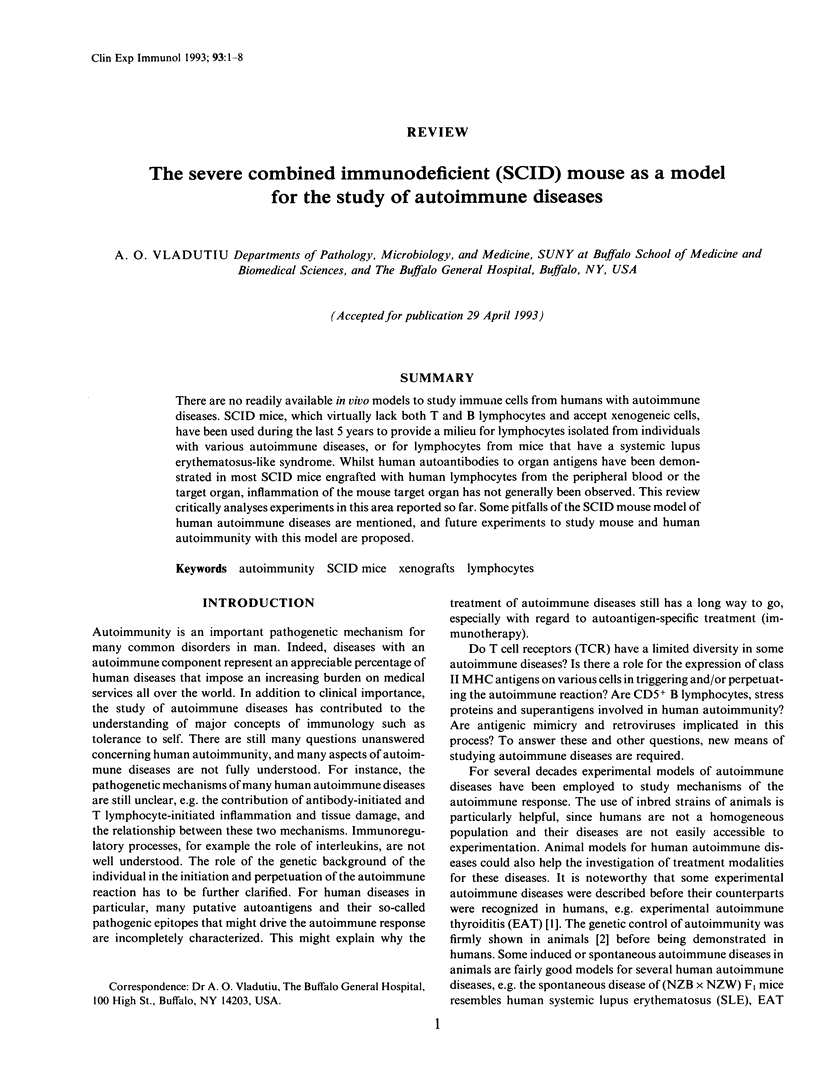
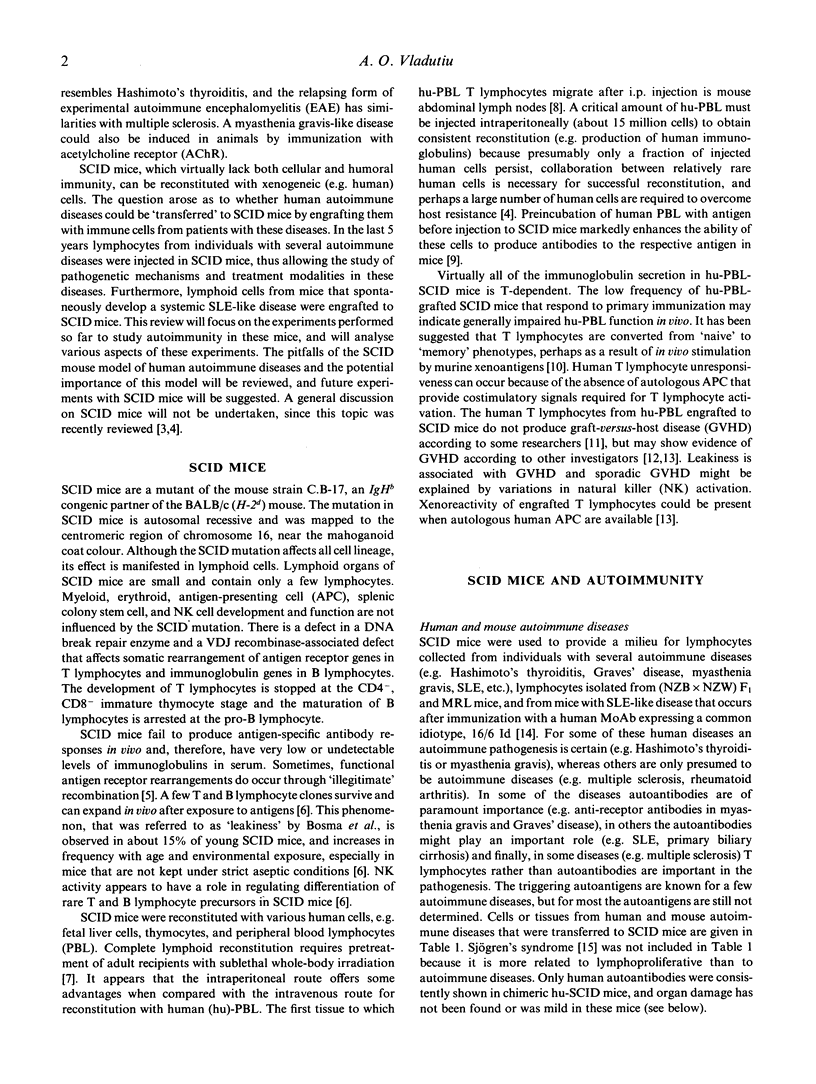
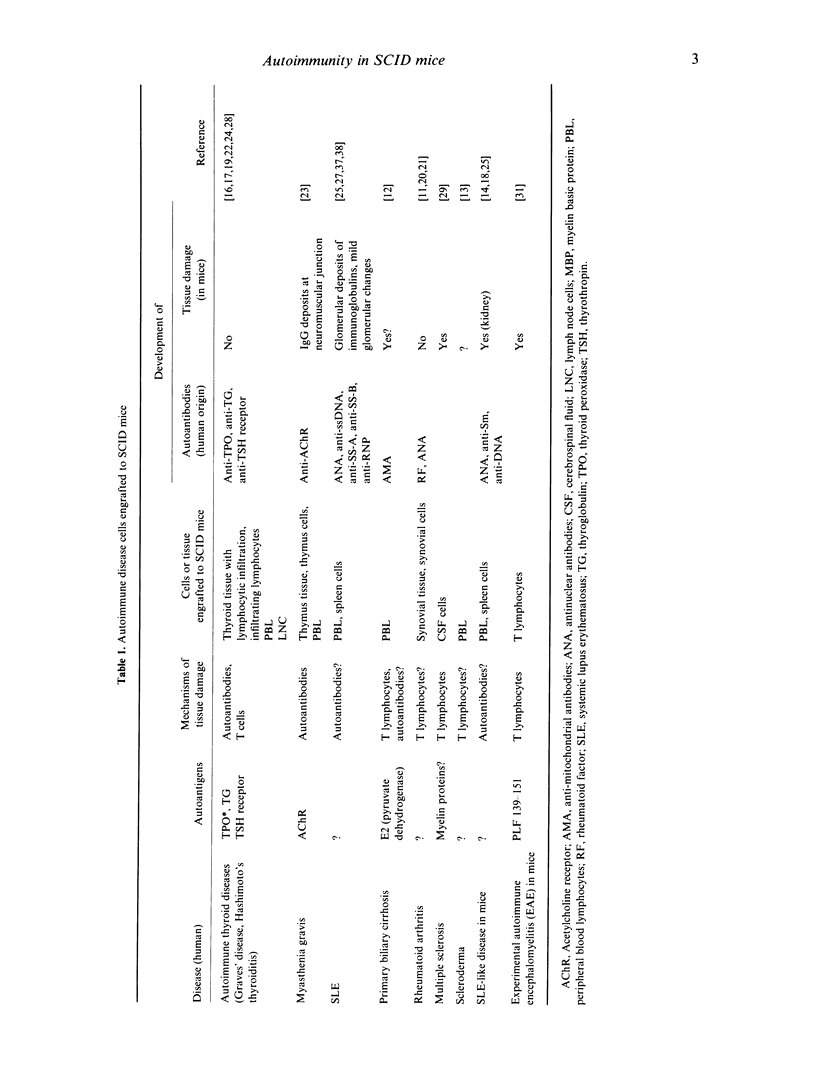
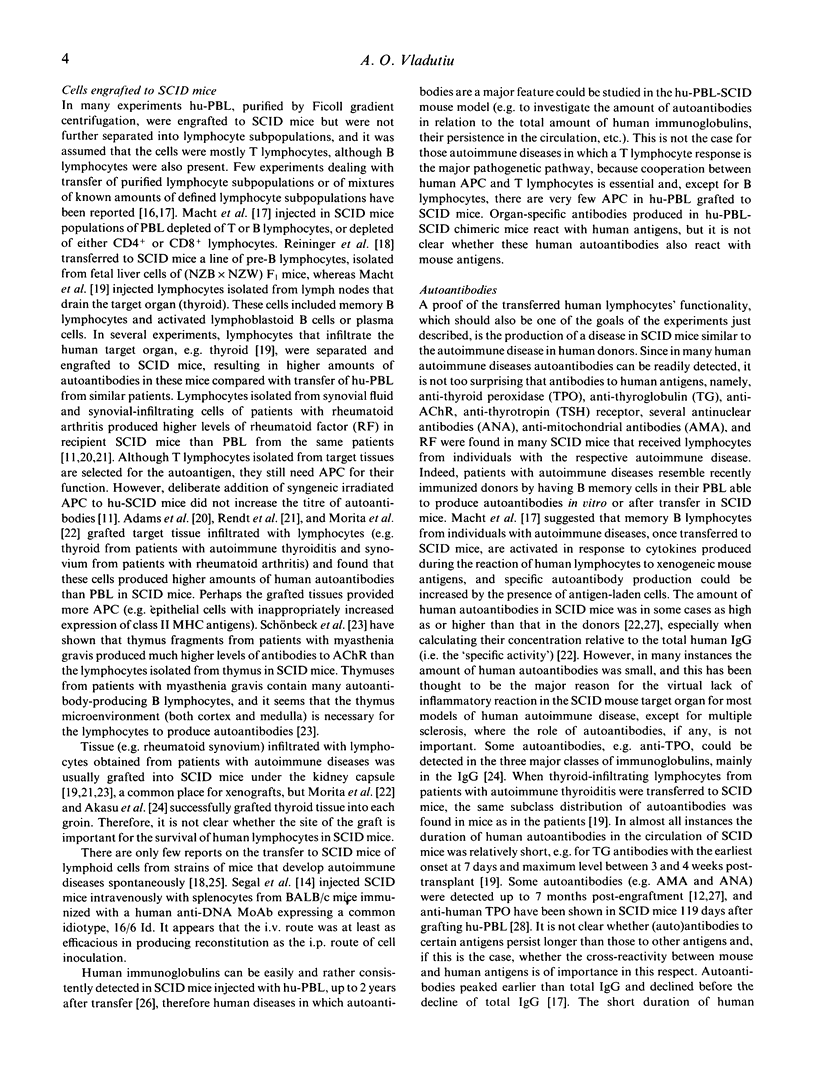
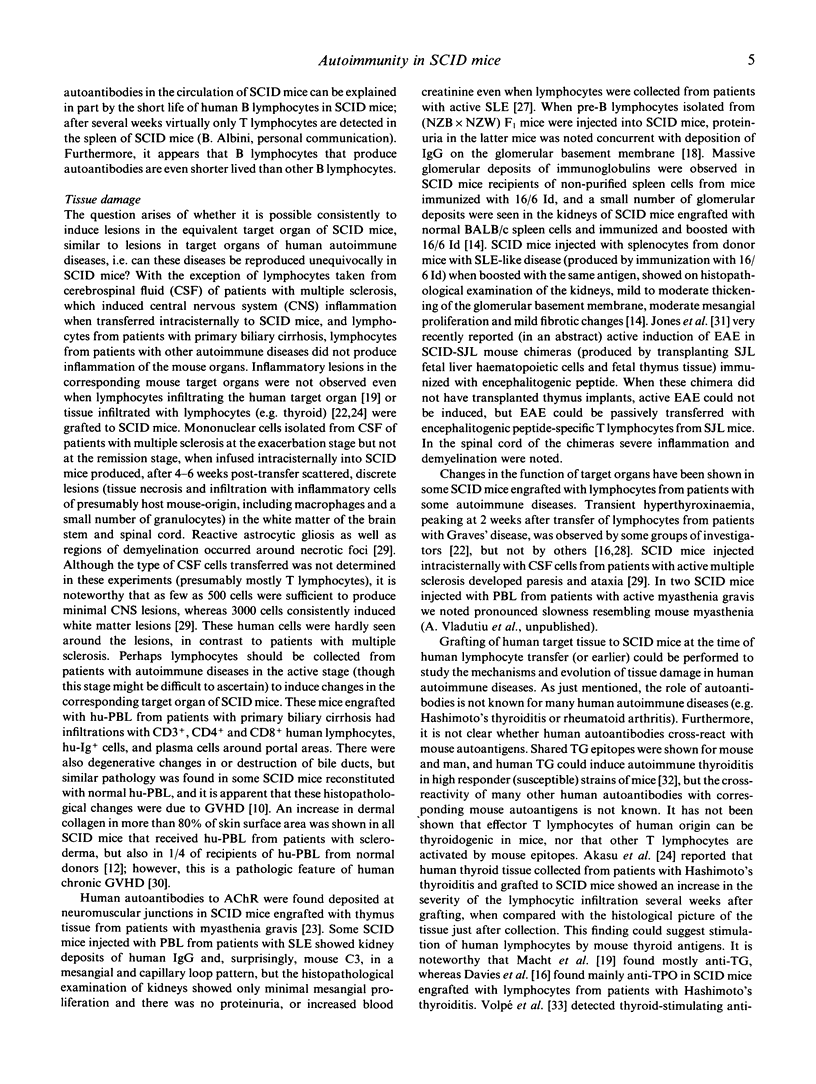
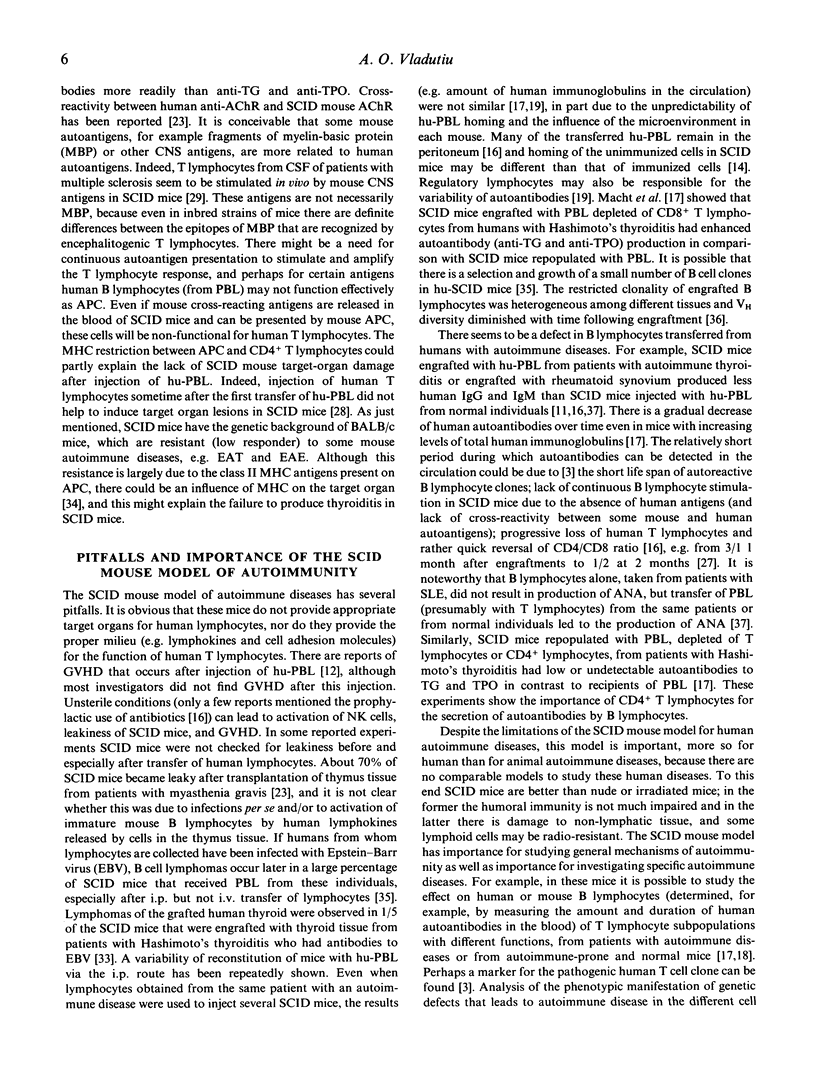
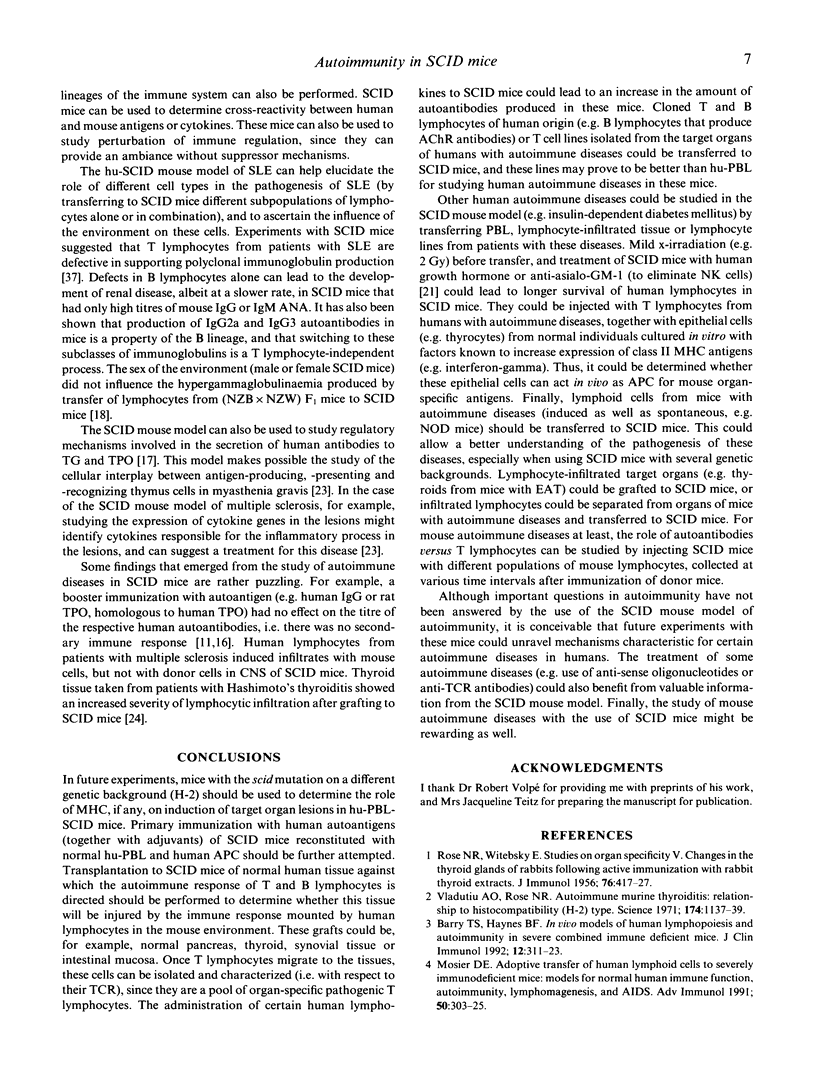
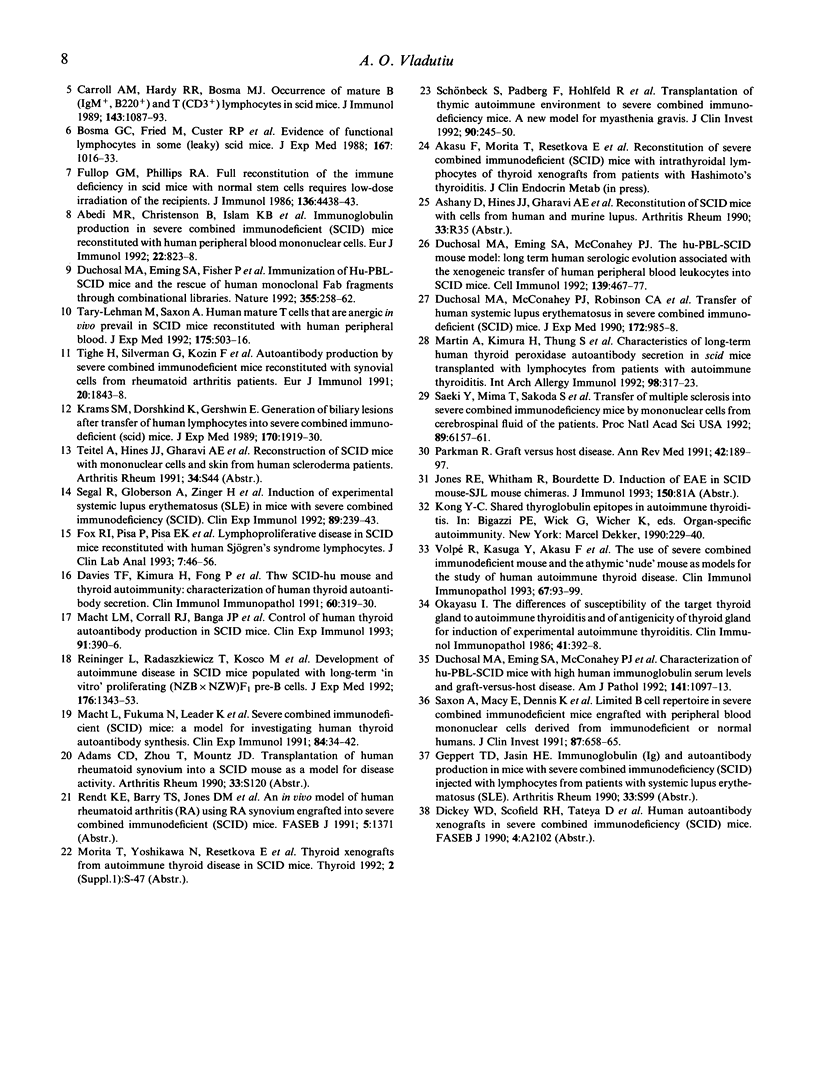
Selected References
These references are in PubMed. This may not be the complete list of references from this article.
- Abedi M. R., Christensson B., Islam K. B., Hammarström L., Smith C. I. Immunoglobulin production in severe combined immunodeficient (SCID) mice reconstituted with human peripheral blood mononuclear cells. Eur J Immunol. 1992 Mar;22(3):823–828. doi: 10.1002/eji.1830220329. [DOI] [PubMed] [Google Scholar]
- Barry T. S., Haynes B. F. In vivo models of human lymphopoiesis and autoimmunity in severe combined immune deficient mice. J Clin Immunol. 1992 Sep;12(5):311–324. doi: 10.1007/BF00920788. [DOI] [PubMed] [Google Scholar]
- Blind E., Schmidt-Gayk H., Sinn H. P., O'Connor D. T., Raue F. Chromogranin A as tumor marker in medullary thyroid carcinoma. Thyroid. 1992 Spring;2(1):5–10. doi: 10.1089/thy.1992.2.5. [DOI] [PubMed] [Google Scholar]
- Bosma G. C., Fried M., Custer R. P., Carroll A., Gibson D. M., Bosma M. J. Evidence of functional lymphocytes in some (leaky) scid mice. J Exp Med. 1988 Mar 1;167(3):1016–1033. doi: 10.1084/jem.167.3.1016. [DOI] [PMC free article] [PubMed] [Google Scholar]
- Carroll A. M., Hardy R. R., Bosma M. J. Occurrence of mature B (IgM+, B220+) and T (CD3+) lymphocytes in scid mice. J Immunol. 1989 Aug 15;143(4):1087–1093. [PubMed] [Google Scholar]
- Davies T. F., Kimura H., Fong P., Kendler D., Shultz L. D., Thung S., Martin A. The SCID-hu mouse and thyroid autoimmunity: characterization of human thyroid autoantibody secretion. Clin Immunol Immunopathol. 1991 Aug;60(2):319–330. doi: 10.1016/0090-1229(91)90075-l. [DOI] [PubMed] [Google Scholar]
- Duchosal M. A., Eming S. A., Fischer P., Leturcq D., Barbas C. F., 3rd, McConahey P. J., Caothien R. H., Thornton G. B., Dixon F. J., Burton D. R. Immunization of hu-PBL-SCID mice and the rescue of human monoclonal Fab fragments through combinatorial libraries. Nature. 1992 Jan 16;355(6357):258–262. doi: 10.1038/355258a0. [DOI] [PubMed] [Google Scholar]
- Duchosal M. A., Eming S. A., McConahey P. J., Dixon F. J. Characterization of hu-PBL-SCID mice with high human immunoglobulin serum levels and graft-versus-host disease. Am J Pathol. 1992 Nov;141(5):1097–1113. [PMC free article] [PubMed] [Google Scholar]
- Duchosal M. A., McConahey P. J., Robinson C. A., Dixon F. J. Transfer of human systemic lupus erythematosus in severe combined immunodeficient (SCID) mice. J Exp Med. 1990 Sep 1;172(3):985–988. doi: 10.1084/jem.172.3.985. [DOI] [PMC free article] [PubMed] [Google Scholar]
- Fox R. I., Pisa P., Pisa E. K., Kang H. I. Lymphoproliferative disease in SCID mice reconstituted with human Sjögren's syndrome lymphocytes. J Clin Lab Anal. 1993;7(1):46–56. doi: 10.1002/jcla.1860070109. [DOI] [PubMed] [Google Scholar]
- Fulop G. M., Phillips R. A. Full reconstitution of the immune deficiency in scid mice with normal stem cells requires low-dose irradiation of the recipients. J Immunol. 1986 Jun 15;136(12):4438–4443. [PubMed] [Google Scholar]
- Krams S. M., Dorshkind K., Gershwin M. E. Generation of biliary lesions after transfer of human lymphocytes into severe combined immunodeficient (SCID) mice. J Exp Med. 1989 Dec 1;170(6):1919–1930. doi: 10.1084/jem.170.6.1919. [DOI] [PMC free article] [PubMed] [Google Scholar]
- Macht L. M., Corrall R. J., Banga J. P., Elson C. J. Control of human thyroid autoantibody production in SCID mice. Clin Exp Immunol. 1993 Mar;91(3):390–396. doi: 10.1111/j.1365-2249.1993.tb05914.x. [DOI] [PMC free article] [PubMed] [Google Scholar]
- Macht L., Fukuma N., Leader K., Sarsero D., Pegg C. A., Phillips D. I., Yates P., McLachlan S. M., Elson C., Rees Smith B. Severe combined immunodeficient (SCID) mice: a model for investigating human thyroid autoantibody synthesis. Clin Exp Immunol. 1991 Apr;84(1):34–42. doi: 10.1111/j.1365-2249.1991.tb08120.x. [DOI] [PMC free article] [PubMed] [Google Scholar]
- Martin A., Kimura H., Thung S., Fong P., Shultz L. D., Davies T. F. Characteristics of long-term human thyroid peroxidase autoantibody secretion in scid mice transplanted with lymphocytes from patients with autoimmune thyroiditis. Int Arch Allergy Immunol. 1992;98(4):317–323. doi: 10.1159/000236205. [DOI] [PubMed] [Google Scholar]
- Mosier D. E. Adoptive transfer of human lymphoid cells to severely immunodeficient mice: models for normal human immune function, autoimmunity, lymphomagenesis, and AIDS. Adv Immunol. 1991;50:303–325. doi: 10.1016/s0065-2776(08)60828-7. [DOI] [PubMed] [Google Scholar]
- Okayasu I. The differences of susceptibility of the target thyroid gland to autoimmune thyroiditis and of antigenicity of thyroid gland for induction of experimental autoimmune thyroiditis. Clin Immunol Immunopathol. 1986 Dec;41(3):392–398. doi: 10.1016/0090-1229(86)90009-7. [DOI] [PubMed] [Google Scholar]
- Parkman R. Graft-versus-host disease. Annu Rev Med. 1991;42:189–197. doi: 10.1146/annurev.me.42.020191.001201. [DOI] [PubMed] [Google Scholar]
- ROSE N. R., WITEBSKY E. Studies on organ specificity. V. Changes in the thyroid glands of rabbits following active immunization with rabbit thyroid extracts. J Immunol. 1956 Jun;76(6):417–427. [PubMed] [Google Scholar]
- Reininger L., Radaszkiewicz T., Kosco M., Melchers F., Rolink A. G. Development of autoimmune disease in SCID mice populated with long-term "in vitro" proliferating (NZB x NZW)F1 pre-B cells. J Exp Med. 1992 Nov 1;176(5):1343–1353. doi: 10.1084/jem.176.5.1343. [DOI] [PMC free article] [PubMed] [Google Scholar]
- Saeki Y., Mima T., Sakoda S., Fujimura H., Arita N., Nomura T., Kishimoto T. Transfer of multiple sclerosis into severe combined immunodeficiency mice by mononuclear cells from cerebrospinal fluid of the patients. Proc Natl Acad Sci U S A. 1992 Jul 1;89(13):6157–6161. doi: 10.1073/pnas.89.13.6157. [DOI] [PMC free article] [PubMed] [Google Scholar]
- Saxon A., Macy E., Denis K., Tary-Lehmann M., Witte O., Braun J. Limited B cell repertoire in severe combined immunodeficient mice engrafted with peripheral blood mononuclear cells derived from immunodeficient or normal humans. J Clin Invest. 1991 Feb;87(2):658–665. doi: 10.1172/JCI115043. [DOI] [PMC free article] [PubMed] [Google Scholar]
- Schönbeck S., Padberg F., Hohlfeld R., Wekerle H. Transplantation of thymic autoimmune microenvironment to severe combined immunodeficiency mice. A new model of myasthenia gravis. J Clin Invest. 1992 Jul;90(1):245–250. doi: 10.1172/JCI115843. [DOI] [PMC free article] [PubMed] [Google Scholar]
- Segal R., Globerson A., Zinger H., Mozes E. Induction of experimental systemic lupus erythematosus (SLE) in mice with severe combined immunodeficiency (SCID). Clin Exp Immunol. 1992 Aug;89(2):239–243. doi: 10.1111/j.1365-2249.1992.tb06938.x. [DOI] [PMC free article] [PubMed] [Google Scholar]
- Tary-Lehmann M., Saxon A. Human mature T cells that are anergic in vivo prevail in SCID mice reconstituted with human peripheral blood. J Exp Med. 1992 Feb 1;175(2):503–516. doi: 10.1084/jem.175.2.503. [DOI] [PMC free article] [PubMed] [Google Scholar]
- Tighe H., Silverman G. J., Kozin F., Tucker R., Gulizia R., Peebles C., Lotz M., Rhodes G., Machold K., Mosier D. E. Autoantibody production by severe combined immunodeficient mice reconstituted with synovial cells from rheumatoid arthritis patients. Eur J Immunol. 1990 Aug;20(8):1843–1848. doi: 10.1002/eji.1830200832. [DOI] [PubMed] [Google Scholar]
- Vladutiu A. O., Rose N. R. Autoimmune murine thyroiditis relation to histocompatibility (H-2) type. Science. 1971 Dec 10;174(4014):1137–1139. doi: 10.1126/science.174.4014.1137. [DOI] [PubMed] [Google Scholar]
- Volpé R., Kasuga Y., Akasu F., Morita T., Yoshikawa N., Resetkova E., Arreaza G. The use of the severe combined immunodeficient mouse and the athymic "nude" mouse as models for the study of human autoimmune thyroid disease. Clin Immunol Immunopathol. 1993 May;67(2):93–99. doi: 10.1006/clin.1993.1050. [DOI] [PubMed] [Google Scholar]


